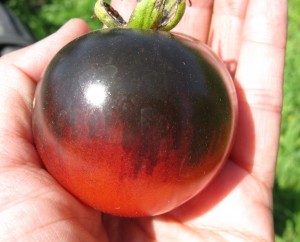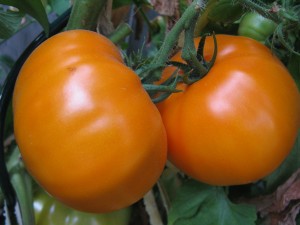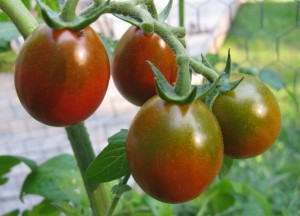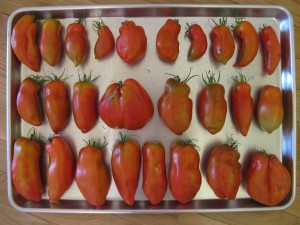There is nothing more symbolic of home gardening than the tomato. And with good reason: the closer a tomato is grown to home, the better it tastes!
 There are literally hundreds of tomato varieties, and plant breeders are working hard to create more. Tomatoes come in all sizes, from marble-sized, to ones over 2 pounds. They also come in many different colours other than the traditional red, including white, green, and dark purple (like an eggplant).
There are literally hundreds of tomato varieties, and plant breeders are working hard to create more. Tomatoes come in all sizes, from marble-sized, to ones over 2 pounds. They also come in many different colours other than the traditional red, including white, green, and dark purple (like an eggplant).
The varieties of tomatoes you find in the grocery store have been selected for traits that are important for a commercial crop: the fruit all tend to ripen in a short period of time, they transport well, and are resistant to common diseases. Taste is well down on their list of important qualities.
 The home grower is not restricted by these factors, and can select varieties based on taste. Contrary to the commercial grower, you may prefer to have the fruit ripen over a long period of time, so you are not inundated all at once. Although that’s not a terrible problem to have, since there are so many things you can do with tomatoes! Marinara sauce, salsa, tortilla soup, in a salad, on a sandwich or hamburger, or just as a snack, the list is endless…
The home grower is not restricted by these factors, and can select varieties based on taste. Contrary to the commercial grower, you may prefer to have the fruit ripen over a long period of time, so you are not inundated all at once. Although that’s not a terrible problem to have, since there are so many things you can do with tomatoes! Marinara sauce, salsa, tortilla soup, in a salad, on a sandwich or hamburger, or just as a snack, the list is endless…
To grow your own tomatoes, you can buy plants that have already been started. It is becoming easier to find more than just two or three varieties of plants than in the past, and you may be lucky enough to find some heirloom tomato plants at your local farmer’s market. But for the best selection, you should start them yourself from seed.
 Tomato seeds need temperatures of at least 70˚F to germinate well. The top of the fridge works well for this, or a heating mat. Start them 4-5 weeks before your last frost date, and transplant two weeks after your last frost date. The seedlings will not withstand frost, so make sure to cover them if a late frost is in the forecast.
Tomato seeds need temperatures of at least 70˚F to germinate well. The top of the fridge works well for this, or a heating mat. Start them 4-5 weeks before your last frost date, and transplant two weeks after your last frost date. The seedlings will not withstand frost, so make sure to cover them if a late frost is in the forecast.
Tomatoes have a relatively unique ability to grow roots out of their stems. When transplanting, take advantage of this by planting them deeply. You can bury the plant up to the embryonic leaves, or even the first set of true leaves. The buried stem will develop roots, adding to the stability of the plant, and also its ability to scrounge for nutrients.
 There are two main types of tomato plants, defined by their growth habits. Determinate plants are short and bushy, and the fruit tends to ripen all at once. Indeterminate plants grow tall and vine-like, and will produce fruit over the entire summer. Determinate plants can use support like the short, round tomato cages that are easy to find in the stores. Indeterminate plants will outgrow these cages quickly, and are better tied to poles. Some varieties will grow over 6′ tall!
There are two main types of tomato plants, defined by their growth habits. Determinate plants are short and bushy, and the fruit tends to ripen all at once. Indeterminate plants grow tall and vine-like, and will produce fruit over the entire summer. Determinate plants can use support like the short, round tomato cages that are easy to find in the stores. Indeterminate plants will outgrow these cages quickly, and are better tied to poles. Some varieties will grow over 6′ tall!
I usually grow indeterminate plants because I like the staggered maturity, and also there are many more indeterminate than determinate varieties available.
If you haven’t tried growing tomatoes, what are you waiting for? Fantastic flavour is waiting for you!
Tomato (Lycopersicon esculentum)
sowing style: as a transplant (use bottom heat)
timing: start 4-5 weeks before frost-free date, transplant 2 weeks after
requirements: full sun
spacing: 20″ (determinate), 24″ (indeterminate)
height: depends on variety (30″ to 7’+)
yield: depends on variety (anywhere from 5 to 300 tomatoes per plant)

